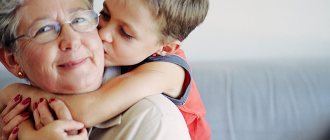At the age of 7 years, a child experiences a crisis in his life. This coincides with the fact that he goes to school and meets other children and teachers. And in order to reduce this period to a minimum, parents should read this useful article: 7-year-old child, psychology of boys.
Characteristic age features
Role-playing games are replacing manipulative games. Parents become role models and transmitters of social norms. A preschooler’s knowledge of the world of relationships between people occurs through role-playing games and communication.
A play environment is a necessary component for the proper psycho-emotional development of a little person. During the game, the baby ceases to be afraid and gets rid of the effects of traumatic moments (for example, nightmares).
For a preschooler:
- there is an active development of imagination;
- visual thinking is being formed;
- the formation of thinking with the help of concepts begins;
- your own vision of the world is being rebuilt;
- the motivational system changes;
- there is greater freedom of behavior.
The basis of the new position is the child’s readiness for school. In addition, one should understand the degree of formation of the personality, its characteristic features, and prospects. The psychology of a 7-year-old child consists of the following factors:
- The degree of pretentiousness shows how confident the child is in his abilities. The formation of this feeling occurs thanks to “ups” and “downs”. The more successful results a child gets, the more confident he is. The goal of parents is to encourage the child’s success and guide him in the right direction.
- Perspective implies a goal in life. If a child, looking at adults, realizes that studying is important for achieving future success, he will have a positive attitude towards school. If a child does not understand the meaning of the educational process, he will resist learning with all his might.
- The concept of one's own "I" contains 3 parts: evaluative, emotional and cognitive. A child of preschool age has almost no self-esteem; external criteria are the guideline. For his perception, such qualities as kindness and responsiveness are incomprehensible, but at the level of feelings he understands them. The cognitive part refers to the extent to which a child can describe himself. Emotions characterize the specificity of perception - a child at this age evaluates and remembers everything on an emotional level. Therefore, you can communicate with preschoolers through drawings.
- The motivational and incentive hierarchy is formed by the age of 5–6 years. The baby is able to meaningfully perform actions, he can make choices, analyze the meaning of the action.
Examples of joint games for the whole family
Study becomes the leading activity, but games also play an important role in development, relaxation and recreation.
If a child has favorite games, then you should not ban them - as they grow up, they will gradually fade into the background. Games help you switch your mind and take a break from studying.
Outdoor sports games are useful - they allow you to get rid of excess energy and take a break from the educational process. Children of this age are more drawn to team games
During this period, children may be interested in intellectual games and creativity. Acting out skits and children's theater are excellent examples of play activities. Children develop creatively. Acting out scenes is useful for developing memory and imagination.
Examples of games:
- "Barbell". Allows you to relax and relieve tension. Imagine that there is a barbell on the floor. You have to bend down, take it, take a breath and lift it up. Imagine how hard it is. Then slowly lower down.
- Tactile game. Various objects are placed on the table: hard, soft - a piece of fur, paper, a brush, a cube, etc. An adult passes the object along the child’s hand and asks to talk about the sensations.
- “Freeze in the desired figure . Training attention and movement coordination. It's more fun to play in a group. Everyone moves in a circle, when the leader claps his hands, you must freeze in a certain position. For example, one clap - stork pose, two - bear, three - resume movement.
Distinctive features of the crisis
The main cause of behavioral problems in the preschool period is growing up. The baby’s living conditions completely change, the child is worried and worried. He will need to learn a lot, adapt to a new schedule, and understand his responsibility.
The age-related psychology of a crisis in a 7-year-old child is such that this period is difficult, the child needs to get used to communicating with peers who are also experiencing difficulties, and learn to cope with the school load.
Experts say that the seven-year crisis manifests itself at approximately 6–8 years of age. It is impossible to say an exact figure; each baby is individual. Distinctive features of the period are:
- inappropriate behavior of the child, frequent manifestations of harmfulness;
- fake conversation when communicating;
- decreased perseverance and concentration;
- attempts to imitate adults;
- attempts to attract attention.
Some children try to tell adults. Such changes are unconscious; the child temporarily loses control over his actions. The preschooler reacts negatively to criticism; the mind blocks all negative information coming from the outside.
The main impetus of the crisis is the gradual departure from childish spontaneity, the maturation of the intellect, and the emergence of anxiety for the actions taken. In addition, the child is worried about his success at school and tries to resist changing his usual conditions.
Main mistakes
In order not to aggravate the crisis and not to lose the trust of the child, it is important for parents not to make a number of mistakes:
- Physical punishment. At the same time, the baby experiences humiliation, begins to fear his parents, and loses trust. Physical punishment contributes to a decrease in self-esteem; a younger student may become timid and insecure, in order to avoid reprisals, he begins to lie to his parents, hiding various facts, for example, failures in studies, problems at school, with peers, and mistakes made.
- Criticism: “you are doing poorly,” “you can’t do anything,” “you are a loser” - the child will become firmly established in this opinion, because the opinion of his parents is still important to him. As a result, motivation to study decreases, the individual feels like an outcast, unworthy of rewards, and problems begin with self-identification among peers.
- Forbid communication with a specific boy or girl, saying that he is bad, unworthy, of their dysfunctional family.
- You cannot say one thing today and change your mind tomorrow: “You are already an adult, you must fulfill such and such duties,” and the next day: “You are small, you cannot do this.”
- Compare with other children, say that the child studies and behaves worse, other children are better. This reduces self-esteem and motivation.
- You can't make fun of people for mistakes or blunders. If a child did something wrong, you need to calmly explain to him how it should have been done or why it should not have been done.
- Raise your voice. The child becomes nervous, motivation to study decreases, and hysterics are possible.
Symptoms
Parents themselves can identify the psychological characteristics of this period. Each has its own logic.
The child stops obeying subconsciously, tries to insist on his opinion, refusal to follow parental orders helps development. Punishment is undesirable; even a calm explanation rarely helps. It's better to try to step away temporarily.
Stubbornness is also a symptom of a crisis period. The baby denies refusals, becomes demanding and persistent. In this way he asserts himself. The goal itself is not important, the main thing is the process of demand.
The consequence of the first symptoms is self-will. The child wants to do everything on his own. The best way out is to try to direct energy in the desired direction: provide limited freedom of choice, give simple tasks. For example, choosing clothes, food from several proposed options.
Initial signs may be noted by the age of six. Closer to eight years of age, symptoms become more smoothed out.
Features of attention
This mental feature is the most important; the learning process is based on attention. Previously, children could not concentrate on monotonous actions, but at seven years old this is not an impossible task. But involuntary attention continues to lead. Any stimulus can serve as a distraction. The average duration of concentration is 10–20 minutes. Difficulties arise with switching attention between tasks. Children are individual, each one develops attention differently. Some can quickly switch from task to task, but are unable to maintain attention for a long time. Others may meticulously, very carefully work on a solution, but take a long time to switch to solving the next problem.
The properties of attention are not equally amenable to training and development, but they can and should be developed. This must be done in order not to let this process take its course. Only by the age of 9–10 can you count on perseverance and concentration, which will allow you to complete tasks for a long time. Until this time, voluntary attention will prevail, switching to an external stimulus. Because of this mental property, the best way to deliver educational material is through colorful aids and materials.
Recommendations for development:
- games of dominoes, lotto;
- search for drawn identical objects depicted in the same picture;
- searching for differences between two pictures that are identical at first glance.
How to behave as parents
In raising a child, panic is the worst advisor. You should get together and follow the recommendations of experts.
When prohibiting, it is necessary to provide justification. Each limitation should be presented in the form of advice or wishes. Then there will be no sharp refusal.
Listen to your baby, spend more time together. Let the child trust you. Always listen to his fears and worries. You can't mock his worries. In the future, this will help the child cope with the fear of speaking in public.
Ask your child for advice often. He will feel the importance of his opinion for adults. Discuss shopping, daily chores, school, work. But at the same time, you don’t need to burden your baby too much with your difficulties.
Violence for educational purposes contributes to the aggravation of the situation and can leave an imprint on the child’s entire life and reduce his self-esteem.
At the age of 7, the child begins to grow up, you need to perceive him as an adult, full-fledged person. The child should communicate with peers more often and try to fulfill his responsibilities independently. It is advisable that the baby has his own place of solitude.
Main indicators of children's physical development
Indicator name | 7 years | 8 years |
| Height | 121.2 cm | 126.9 cm |
| Body mass | 22.9 kg | 25.5 kg |
| Head circumference | 52 cm | 58 cm |
| Chest circumference | 52 cm | 59 cm |
| Breathing rate | 20–25 breaths per minute | |
| Heart rate | 85–100 beats per minute | |
| Arterial pressure | 90/60 | |
| Muscle volume | 25% body weight | |
| Heart weight | 92.3 grams | |
Additional age-related features of the development of children 7–8 years old:
- Changing the proportions of the head and body, bringing the indicator closer to an adult.
- Increased limb length by 2 times.
- Rapid development of the musculoskeletal system, especially the spine. Bones are amenable to changes in shape and structure. A colossal load on the skeleton caused by prolonged participation in classes where you have to hold a static pose for a long time. This makes it difficult for children to sit still. Hence the risk of problems with posture.
- The beginning of ossification and a rapid increase in the volume of large muscles. Cross-country exercises, jumping exercises, and roller skating will be useful.
- The ability to instantly orient yourself and adjust while performing exercises.
- Insufficient strength of the small muscles of the hands, leading to complaints of pain and fatigue when writing.
- Changing abdominal breathing to chest breathing, strengthening the diaphragm.
- Completion of the formation of the lung structure.
- Restructuring the functioning of the immune system, redistributing loads from the thymus gland to the lymph nodes, spleen, tonsils, bone marrow.
- Replacement of front milk teeth with molars.
- Insufficient development of nervous regulation of movement, which leads to difficulties in the accuracy of movements and the speed of their execution.
- Vision as the main controller of the processes of writing and drawing. The main feature is fixing attention on the entire process, and not just on a piece of paper. Excessive tension caused by effort is noticeable.
In a 7–8 year old schoolchild, the body is in the process of growth. Health problems are a common cause of fatigue, poor performance, and poor performance.
Duration of the crisis period
The beginning of the crisis period is associated with obtaining the status of a schoolchild, which implies significant changes in the child’s living conditions: a new team, obligations, skills. Based on the research, it has been revealed that this period usually lasts several months, depending on the characteristics of the particular child and the behavior of the parents.
Several stages of the crisis can be distinguished:
- the child realizes the need to go to school, therefore he will grow up and become more important;
- the baby tries to master his emotional state and begins to communicate more calmly;
- full awareness of the new status.
Development of thought processes
Thinking moves from algorithm to algorithm, and in the end, verbal thinking begins to develop. The ability to think figuratively is visible, but the adult logic of judgment has not been acquired. By the end of the period, children will be able to generalize and make connections. This is important for the development of mental abilities. Most intellectual problems are solved with the help of imaginative thinking, which helps to understand the essence of the problem, draw parallels with reality and control its solution.
Most will easily imagine an object in their imagination and highlight its main features. The beginning of the formation of thinking is noticeable, helping to reproduce what is seen in the form of diagrams, drawings, plans. Thanks to this type of thinking, an understanding of the symbols of words in a sentence or mathematical operations will appear. The foundations of algorithm-based thinking are beginning to take shape. This type of thinking is the main thing for an adult individual. Characteristic is an understanding of the simplest cause-and-effect relationships and the ability to use phrases “if... then.”
Recommendations for development:
- composing words from given letters;
- composing sentences from given letters;
- solving puzzles.
It is important to remember that you need to complete all tasks in a playful way, coming up with exciting exercises.
Causes of a child's crisis state
Age crises are normal stages in the development of a person’s personality. During their course, a transformation of a person’s thinking occurs, which leads to his preparation for new stages of life.
The 7-year crisis is noted by psychologists as one of the most turbulent. At this time, children's spontaneity is lost and the baby's position in society is formed.
During this period, a complete restructuring of the behavior of the little person is carried out. He goes to school, which implies a number of innovations: the child must maintain discipline and a certain order.
In the process of communicating with classmates, the baby learns to communicate. Moreover, it does not happen just like that, but for a reason.
The student realizes two truths. The first is that he needs to take into account the opinions of others and sometimes restrain his needs for a while. The second is that the baby grows up and gets his place in the world of adults, which, in his opinion, gives him the right to own “adult” things.
The child attends school for various reasons:
- Game. In this case, the child perceives school as a game, but he is not ready to fulfill the requirements.
- Demonstrative. Kids are excited about new things; they are perceived as a stage of growing up. But even in this case, the child does not want to obey, do homework, or read.
- Educational. By the age of seven, very few people have such motivation. But such children are happy to attend school to gain knowledge. This approach causes the least amount of trauma to the child’s mental state and allows him to quickly adapt to a change in environment.
The difference between boys and girls from a psychological point of view
Psychology of an 8-year-old girl child: the child becomes assiduous, calm, neat, and focused. She is a good student and behaves appropriately. Girls begin to share secrets, they become interested in boys, and in the absence of reciprocity they become very upset. Girls are attracted to dancing and handicraft clubs. The mood is always balanced, they agree with everything and fulfill the tasks assigned to them.
Psychology of an 8-year-old boy: the child is very active, constantly sees competition among his peers. They brag to each other about their knowledge of military equipment or weapons. Their emotional state is unstable, they do not know how to hide their feelings, so they can burst into tears over any little thing. They are only interested in those games whose rules they know and understand. It is almost impossible to teach them to be neat; they cannot withstand monotonous work and perseverance during a lesson.
The psychology of an 8-year-old child is structured in such a way that he needs authority. He needs a person whom he will look up to and try to look like. Boys look for them among their peers and in frequent cases they become children who are not the best behaved.
Possible changes
Undoubtedly, a child’s crisis is a difficult period not only for him, but also for all other family members. It is accompanied by disputes and stress. But, nevertheless, there are also beneficial consequences of this phenomenon:
- Gradually, a readiness to attend school lessons develops: the child tries to complete all tasks in order to be praised. He tries to please his classmates and teachers.
- The baby shows his “I” - he accepts the obligations that have appeared, adapts to the restrictions.
- The kid tries to comprehend his condition. He can explain his feelings: anger, resentment, joy. This is a huge leap in development, which is very important in the development of personality.
Mental characteristics
Most have mastered conversational skills. The vocabulary and interest in learning unknown words increases. An understanding of the sound difference between speech and pronunciation comes. If the social environment was positive and adults communicated well and for a long time, by the first grade the child can express thoughts, retell stories or animated films in colors.
- The ability to comprehend and analyze what is seen or heard is traced, and the purposefulness of actions is visible.
- The development of perception is characterized by observing, searching, examining, studying.
- Speech helps develop the ability to understand.
- Children are able to name and make the qualities and properties of objects the main ones for themselves, separate them and understand the real connection between them.
- At the age of nine years, perception can become generalizing, and the ability to establish connections in perceived phenomena and events develops.
Unwanted actions from parents
How easily the crisis will pass depends on the behavior of the parents and other adults around the child. Below are recommendations for parents:
- Take your child to school no earlier than 7 years old.
- Make adequate demands. Excessive school load leads to serious negative consequences.
- No attempts to control the child’s actions or overprotectiveness. You need to give your baby space to do his own thing.
- Aggression is unacceptable.
- If your performance is poor, you need to show maximum calm and try to find out the reasons.
What are the reasons for the changed character and behavior of children?
Psychology of a 6-year-old child: girls and boys believe that if they have crossed the threshold of school, it means they have entered the path of adulthood. They try to find solutions themselves and act as they see fit. If parents force them to do something they don’t like, seven-year-olds may resist. The reason for this behavior is a change in values, a different perception of the world and an awareness of one’s purpose in society.
Various external factors influence children's mood. Sometimes behavior may not be at all appropriate for a particular situation. And all because of the desire to get rid of mental influence from parents and thus assert oneself. This problem occurs more often with boys.
The psychology of raising 8-year-old girls requires virtually no effort. They are more restrained and are rarely aggressive, showing inadequacy to others. Also, a child’s unstable psyche may be caused by the desire to be a leader. The seven-year-old wants to be like his favorite movie hero, who always solves his problems by using force.
Sometimes children perceive the world around them as a threat. They fearfully wait for some trick from their parents or peers. And there is only one way out of this situation - an attack. And in order not to be punished after this, they begin to behave very emotionally, trying to protect themselves in this way. Children who lack parental affection become rude to elders and offend classmates.
Recommended Actions
In order to get through this difficult period faster, experts recommend adhering to the following rules:
- It is better to show the child the school, its attributes in advance and tell about the order that the child will need to follow. You can take a walk around the school, look into the future class, introduce him to the teacher. Regular stories about school will allow him to adapt much faster, because he will already be ready for what awaits him.
- Try to listen to the baby’s opinion and his arguments.
- Lift some restrictions. Let the baby show independence
- Give your baby more freedom of action.
- Do not point out, but convince by giving arguments.
- Praise for any achievements.
- Reward for good deeds and grades.
- Give your child some responsibilities. For example, cleaning the room, washing dishes.
Mom's influence on the proper upbringing of a girl
In the very first years of a child’s life, the closest person to him is usually his mother. She sits at home with him while his father goes to work and provides for the family. As boys grow older, they become closer to their dad, while girls remain closest to their mother. For a girl, a mother is the very first and main ideal of female beauty and femininity in general. It is not surprising that the girl wants to be like her mother in everything. From her mother, the daughter learns various feminine “wisdoms” - such as cleaning and cooking, washing, creating beautiful things, treating men.











